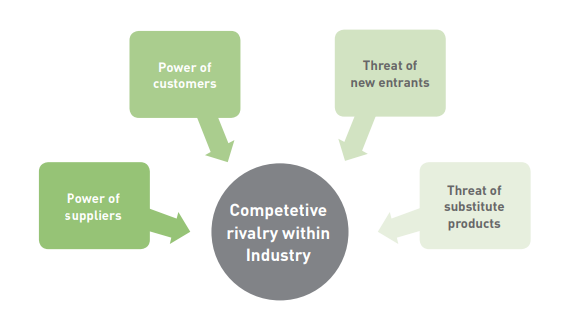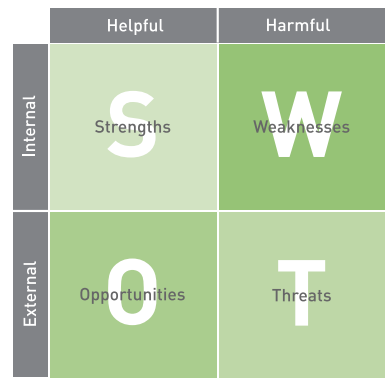1.6: The Building Blocks of Marketing Strategy
- Page ID
- 24863
The following building-block techniques will help you structure a marketing strategy, both online and offline, that addresses your core business challenges. These strategy models are just starting points and ways to help you think through problems. As you grow in experience and insight, you could find yourself relying on them less or adapting them.
Porter’s Five Forces analysis
Porter’s Five Forces analysis is a business tool that helps determine the competitive intensity and attractiveness of a market. The Internet’s low barrier to entry means that many new businesses are appearing online, providing countless choices for customers. This makes it important to consider new factors when devising a marketing strategy.

The Four Ps
The Four Ps of marketing help you structure the components that make up a brand’s offering, differentiators and marketing. They have been fundamentally changed by the Internet and need to be looked at in the context offered by digitally connected media and from the perspective of the consumer. How your brand is positioned in the mind of your consumer will ultimately determine your success.
1. Products (and services)
Products and services are what a company sells. The Internet enables businesses to sell a huge range of products, from fast-moving consumer goods and digital products such as software, to services such as consultancy. In fact, the Internet has in some cases made it possible for a product or service to exist. Consider Uber and Airbnb. Online, the experience the user has in discovering and purchasing can be considered part of the product the brand provides, or be the product itself.
The Internet has enabled hyper-personalisation. For example, Nike (nikeid.nike.com) and Converse (www.converse.com) allow customers to customise their own trainers. The Internet as a distribution medium also makes it possible for products, such as software and music, to be sold digitally.
2. Price
The prevalence of search engines and of shopping comparison websites, such as www.pricerunner.co.uk, and www.nextag.com, makes it easy for customers to compare product prices across a number of retailers. This makes the Internet a market of near-perfect competition (Porter, 2008). The internet allows for personalised and flexible pricing strategies to a level that traditional retailers would find almost impossible to achieve.
With price differentiation becoming a challenge, especially for smaller players in the market, businesses need to consider differentiating on value. Value is a combination of service, perceived benefits and price, where customers may be willing to pay a higher price for a better experience or if they feel they are getting something more than just the product.
3. Placement (or distribution)
Product distribution and markets no longer have to be dictated by location. By simply making their products visible online (for example, on a website or Facebook page), brands can reach a global market. The key is to reach and engage customers on the channels they are using. This is why choosing your digital tactics is vital. You want to engage customers on their terms, not yours.
4. Promotion
The Internet, as an information and entertainment medium, naturally lends itself to promoting products. The online promotional mix is an extension of the offline, but with some significant differences. For one, online promotion can be tracked, measured and targeted in a far more sophisticated way.
Promotion doesn’t just mean advertising and talking at customers. On the Internet, it’s crucial to engage, collaborate and join conversations, too. Interacting with customers helps build relationships, and the web makes this sort of communication easy. That’s why a good portion of this book is devoted to engagement tactics and tools.
Many additional Ps have been suggested and debated over time. We’ve restricted our discussion to the four listed here, but you should do some research and join the debate with your own point of view.
SWOT analysis
A SWOT (Strengths, Weaknesses, Opportunities, Threats) analysis is an ideal way to understand your business and your market.

Always have a purpose in mind when conducting a SWOT analysis. For example, study the external threats to your business, and see how learning from these can help you overcome internal weaknesses. This should tie back in to your business and marketing objectives and strengths should be promoted, opportunities should be sought out, while threats and weaknesses should be minimised as much as possible. A SWOT analysis is part of a situational analysis and identifies the key issues that direct the marketing strategy. Be mindful of the fact that weaknesses can be opportunities and strengths threats, especially in the world of digital disruption.


